tyre pressure Alfa Romeo 8C 2009 Owner handbook (in English)
[x] Cancel search | Manufacturer: ALFA ROMEO, Model Year: 2009, Model line: 8C, Model: Alfa Romeo 8C 2009Pages: 223, PDF Size: 14.35 MB
Page 38 of 223
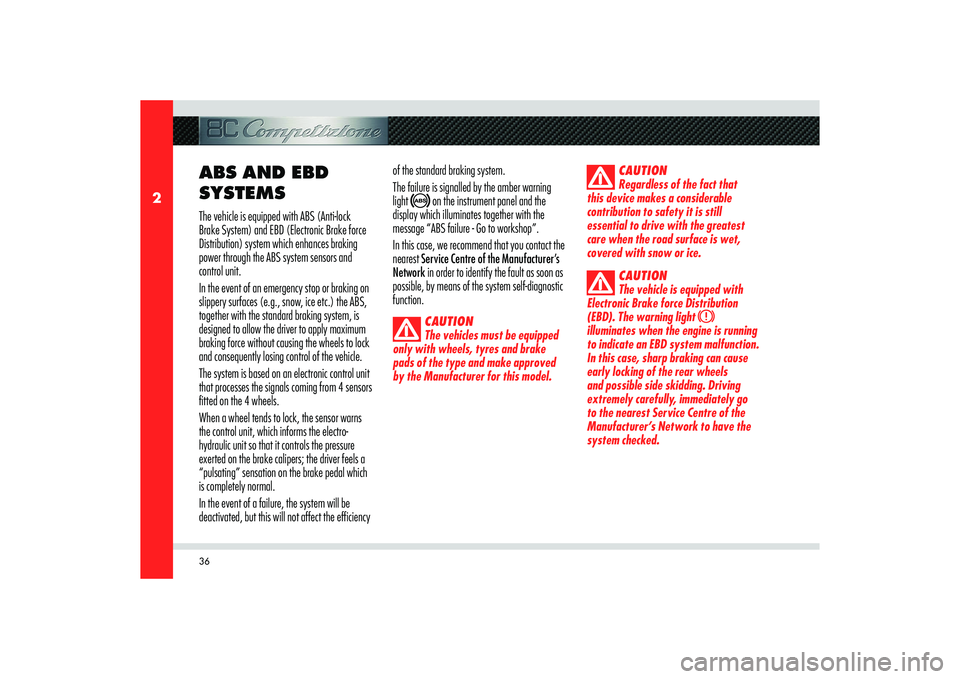
36
2
ABS AND EBD
SYSTEMSThe vehicle is equipped with ABS (Anti-lock
Brake System) and EBD (Electronic Brake force
Distribution) system which enhances braking
power through the ABS system sensors and
control unit.
In the event of an emergency stop or braking on
slippery surfaces (e.g., snow, ice etc.) the ABS,
together with the standard braking system, is
designed to allow the driver to apply maximum
braking force without causing the wheels to lock
and consequently losing control of the vehicle.
The system is based on an electronic control unit
that processes the signals coming from 4 sensors
fitted on the 4 wheels.
When a wheel tends to lock, the sensor warns
the control unit, which informs the electro-
hydraulic unit so that it controls the pressure
exerted on the brake calipers; the driver feels a
“pulsating” sensation on the brake pedal which
is completely normal.
In the event of a failure, the system will be
deactivated, but this will not affect the efficiency of the standard braking system.
The failure is signalled by the amber warning
light
on the instrument panel and the
display which illuminates together with the
message “ABS failure - Go to workshop”.
In this case, we recommend that you contact the
nearest Service Centre of the Manufacturer’s
Network in order to identify the fault as soon as
possible, by means of the system self-diagnostic
function.CAUTION
The vehicles must be equipped
only with wheels, tyres and brake
pads of the type and make approved
by the Manufacturer for this model.CAUTION
Regardless of the fact that
this device makes a considerable
contribution to safety it is still
essential to drive with the greatest
care when the road surface is wet,
covered with snow or ice.
CAUTION
The vehicle is equipped with
Electronic Brake force Distribution
(EBD). The warning light
illuminates when the engine is running
to indicate an EBD system malfunction.
In this case, sharp braking can cause
early locking of the rear wheels
and possible side skidding. Driving
extremely carefully, immediately go
to the nearest Service Centre of the
Manufacturer’s Network to have the
system checked.
Page 132 of 223
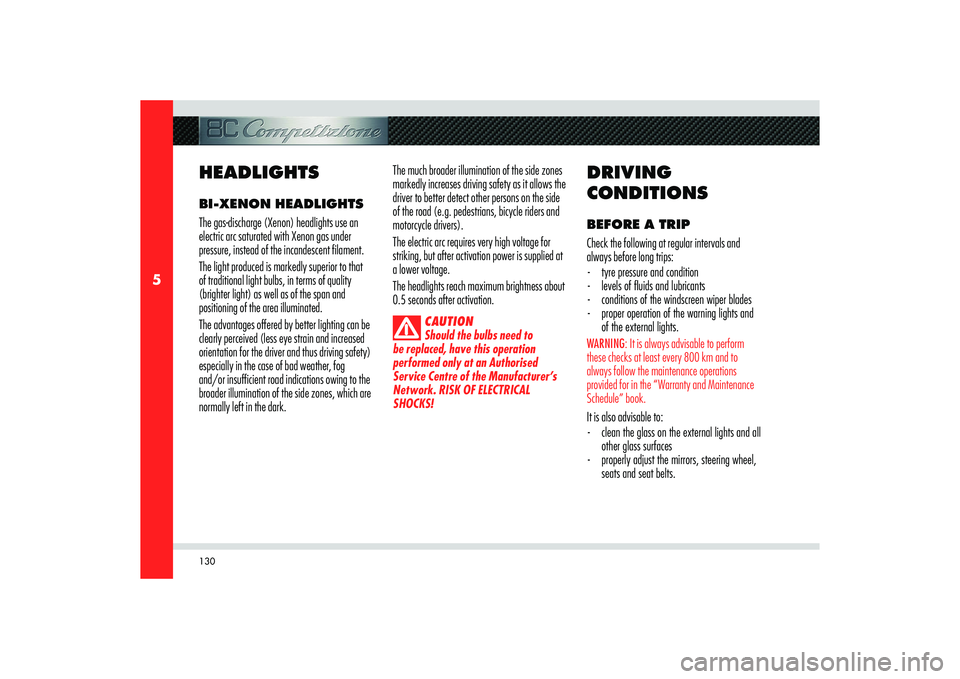
130
5
HEADLIGHTSBI-XENON HEADLIGHTS
The gas-discharge (Xenon) headlights use an
electric arc saturated with Xenon gas under
pressure, instead of the incandescent filament.
The light produced is markedly superior to that
of traditional light bulbs, in terms of quality
(brighter light) as well as of the span and
positioning of the area illuminated.
The advantages offered by better lighting can be
clearly perceived (less eye strain and increased
orientation for the driver and thus driving safety)
especially in the case of bad weather, fog
and/or insufficient road indications owing to the
broader illumination of the side zones, which are
normally left in the dark.The much broader illumination of the side zones
markedly increases driving safety as it allows the
driver to better detect other persons on the side
of the road (e.g. pedestrians, bicycle riders and
motorcycle drivers).
The electric arc requires very high voltage for
striking, but after activation power is supplied at
a lower voltage.
The headlights reach maximum brightness about
0.5 seconds after activation.
CAUTION
Should the bulbs need to
be replaced, have this operation
performed only at an Authorised
Service Centre of the Manufacturer’s
Network. RISK OF ELECTRICAL
SHOCKS!
DRIVING
CONDITIONSBEFORE A TRIP
Check the following at regular intervals and
always before long trips:
- tyre pressure and condition
- levels of fl uids and lubricants
- conditions of the windscreen wiper blades
- proper operation of the warning lights and
of the external lights.WARNING: It is always advisable to perform
these checks at least every 800 km and to
always follow the maintenance operations
provided for in the “Warranty and Maintenance
Schedule” book.It is also advisable to:
- clean the glass on the external lights and all
other glass surfaces
- properly adjust the mirrors, steering wheel,
seats and seat belts.
Page 138 of 223

136
5
OTHER ADVICE
- Do not warm up the engine when the
vehicle is stationary: in these conditions
the engine heats up much more slowly and
increases fuel consumption and emissions.
It is much better to move off slowly,
avoiding high engine RPM.
- As soon as traffi c conditions and the route
permit it, use a higher gear.
- Avoid depressing the accelerator repeatedly
during stops at traffi c lights or before
turning off the engine.
- Keep your speed as regular as possible,
avoiding unnecessary brake applications
and accelerations, which cause fuel wastage
and strongly increase exhaust emissions.
- Turn the engine off if the vehicle remains
stationary for a long time. - Check the tyre pressure regularly: if the
pressure is too low, fuel consumption
increases and the tyres are damaged.
- Do not transport unnecessary objects in
the luggage compartment. The weight
of the vehicle affects fuel consumption
considerably.
- Use the electrical devices only as long as
necessary. The power required increases
fuel consumption.
PARKINGPull the electric parking brake, straighten the
wheels and turn off the engine.
Never leave the ignition key in position MAR.
Always remove the key when getting out of the
vehicle.
CAUTION
Never leave children
unattended in the vehicle.
CAUTION
Do not park the vehicle on
paper, grass, dry leaves or other
flammable materials. They could catch
fire if they come into contact with hot
parts of the exhaust system.
CAUTION
Do not leave the engine running
with the vehicle unattended.
Page 143 of 223

141
5
USING THE VEHICLE
TYRESTYRE INFLATION
PRESSURE WHEN COLD
The tyre inflating ratings shown in this manual
must be read as values applicable with cold
tyres.
CAUTION
When winter tyres are fitted,
it is advisable not to exceed a speed
of 220 km/h. Always observe the
regulations in force in the country
where you are driving and follow
the instructions provided by the tyre
manufacturer.
CAUTION
When using the spare wheel
(emergency wheel) do not exceed 80
km/h. Avoid driving at full throttle,
braking sharply and cornering at high
speeds.
WINTER TYRES
These tyres are specially designed for driving on
snow and ice and are fitted to replace the ones
supplied with the vehicle.
CAUTION
Only use winter tyres having
the same dimensions as those provided
with the vehicle or as indicated on
page 186.
The Authorised Service Centres of the
Manufacturer’s Network are available to
provide suggestions as to the types of tyres most
suited to the use foreseen by the Customer.
For the type of tyres to use, inflation pressures
and relative specifications for winter tyres,
carefully follow the indications found in the
section “Capacities and technical specifications”.
The features of these tyres are markedly reduced
in winter when tread depth is less than 4 mm. In
this case, they should be replaced.The specific features of the winter tyres lead to
lower performance under normal environmental
conditions or on long highway trips, compared to
the standard tyres.
Therefore, they should only be fitted for
their intended use, for which they have been
approved.
CAUTION
Fit identical (manufacturer and
tread) tyres on all four wheels, in
order to ensure safe driving, braking
and good manoeuvrability.
CAUTION
Remember that the direction of
tyre rotation should not be reversed.
Page 150 of 223

148
6
CD
E
F
Remove the cigarette lighter
C, and insert the
connector
D.
Start the engine by pressing the start button (see
page 114).
Press the Fix&Go button
E at position “I”. The
electric compressor will activate and the liquid
with air will inflate the tyre.
A pressure of at least 1.8 bar (26 psi) should
be reached within 20 minutes. If this does not
occur, turn off and remove the Fix&Go kit.
Move the vehicle forward and backward by 10
metres to better distribute the sealant in the tyre.Attach the quick-connector of the compressor
directly on the tyre valve and repeat the inflation
procedure.
If the minimum tyre pressure is not reached,
do not start the vehicle. Contact an Authorised
Service Centre of the Manufacturer’s
Network.
When the correct pressure has been reached,
move the vehicle forward and backward to
evenly distribute the sealant in the tyre.
After 10 minutes, stop and check the tyre
pressure. If the pressure is below 1.3 bar
(19 psi), do not drive the vehicle. The tyre is
excessively damaged. Contact an Authorised Service Centre of the
Manufacturer’s Network.
If the pressure is equal to or greater than 1.3
bar (19 psi), repeat the inflation procedure until
reaching the adequate tyre pressure and resume
driving.
Remove the warning label
F from the bottle and
position it on the dashboard as a reminder to
the driver that the tyre has been treated with
automatic Fix&Go.
Page 151 of 223
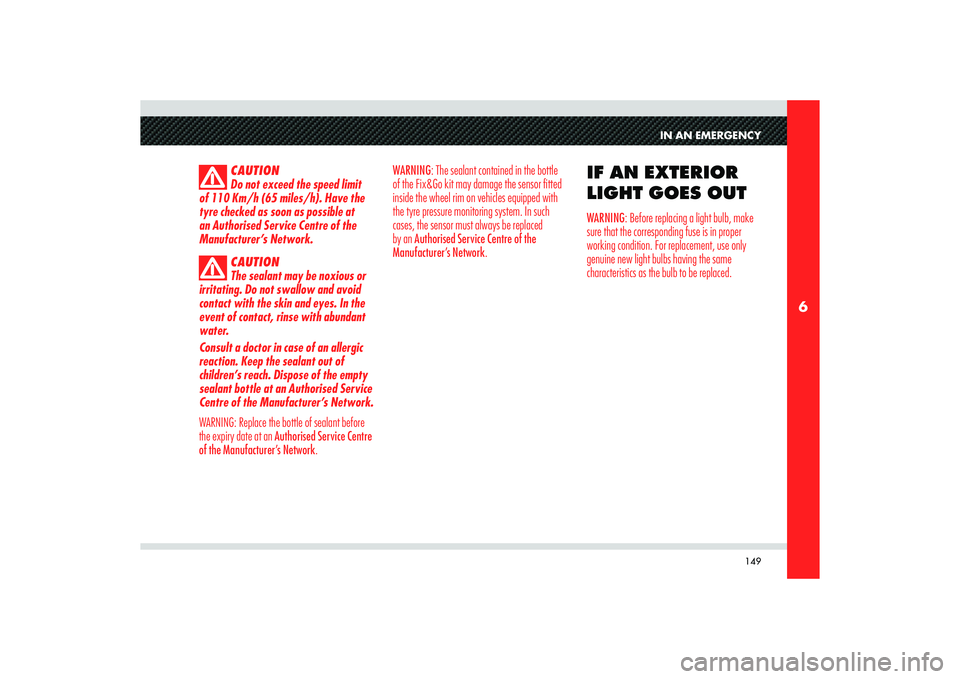
149
6
IN AN EMERGENCY
CAUTION
Do not exceed the speed limit
of 110 Km/h (65 miles/h). Have the
tyre checked as soon as possible at
an Authorised Service Centre of the
Manufacturer’s Network.
CAUTION
The sealant may be noxious or
irritating. Do not swallow and avoid
contact with the skin and eyes. In the
event of contact, rinse with abundant
water.
Consult a doctor in case of an allergic
reaction. Keep the sealant out of
children’s reach. Dispose of the empty
sealant bottle at an Authorised Service
Centre of the Manufacturer’s Network.
WARNING: Replace the bottle of sealant before
the expiry date at an Authorised Service Centre
of the Manufacturer’s Network. WARNING: The sealant contained in the bottle
of the Fix&Go kit may damage the sensor fitted
inside the wheel rim on vehicles equipped with
the tyre pressure monitoring system. In such
cases, the sensor must always be replaced
by an Authorised Service Centre of the
Manufacturer’s Network.
IF AN EXTERIOR
LIGHT GOES OUTWARNING: Before replacing a light bulb, make
sure that the corresponding fuse is in proper
working condition. For replacement, use only
genuine new light bulbs having the same
characteristics as the bulb to be replaced.
Page 177 of 223
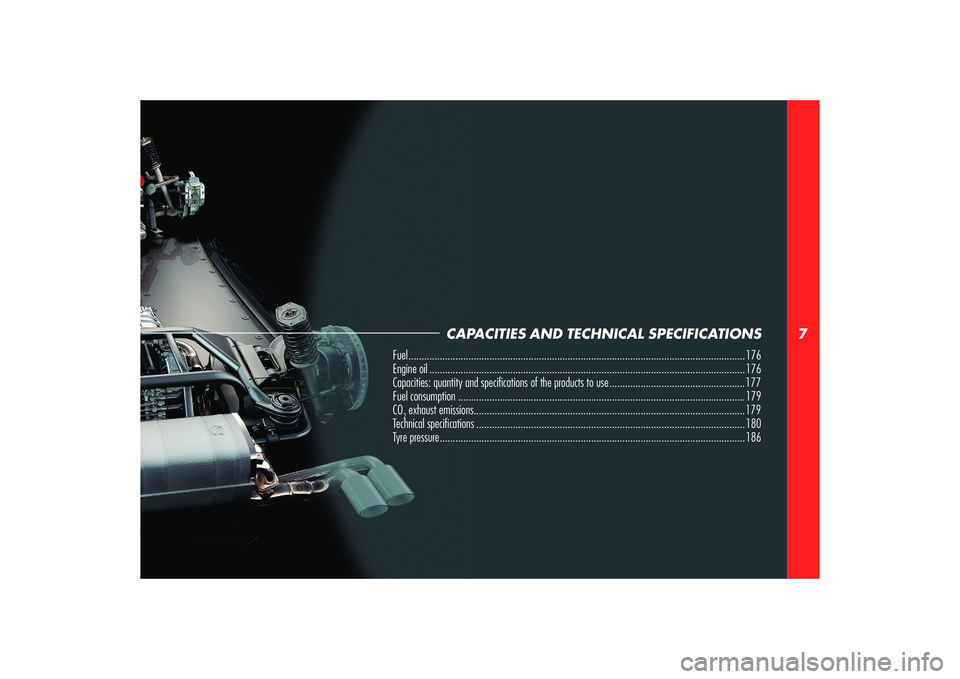
7
CAPACITIES AND TECHNICAL SPECIFICATIONS
Fuel ................................................................................................................................. 176
Engine oil ......................................................................................................................... 176
Capacities: quantity and specifi cations of the products to use .................................................... 177
Fuel consumption ..............................................................................................................179
CO2 exhaust emissions ........................................................................................................ 179
Technical specifi cations ....................................................................................................... 180
Tyre pressure ..................................................................................................................... 186
Page 188 of 223

186
7
TYRE PRESSURETyre inflation pressure when cold (bar).
Wheel rim size Tyre size Infl ation pressure when
cold (bar)
front 8.5”J x 20” 245/35 ZR20 2.2
rear 10.5”J x 20” 285/35 ZR20 2.2
*front 8.5”J x 20” 245/35 ZR20 VM+S 2.2
*rear 10.5”J x 20” 275/35 ZR20 VM+S 2.2
* Winter tyres
CAUTION
Alternatively, you may use winter tyres having the same dimensions as
those provided with the vehicle.
CAUTION
When winter tyres are fitted, it is advisable not to exceed a speed of
220 km/h. Always observe the regulations in force in the country where you are
driving and follow the instructions provided by the tyre manufacturer.
Page 194 of 223
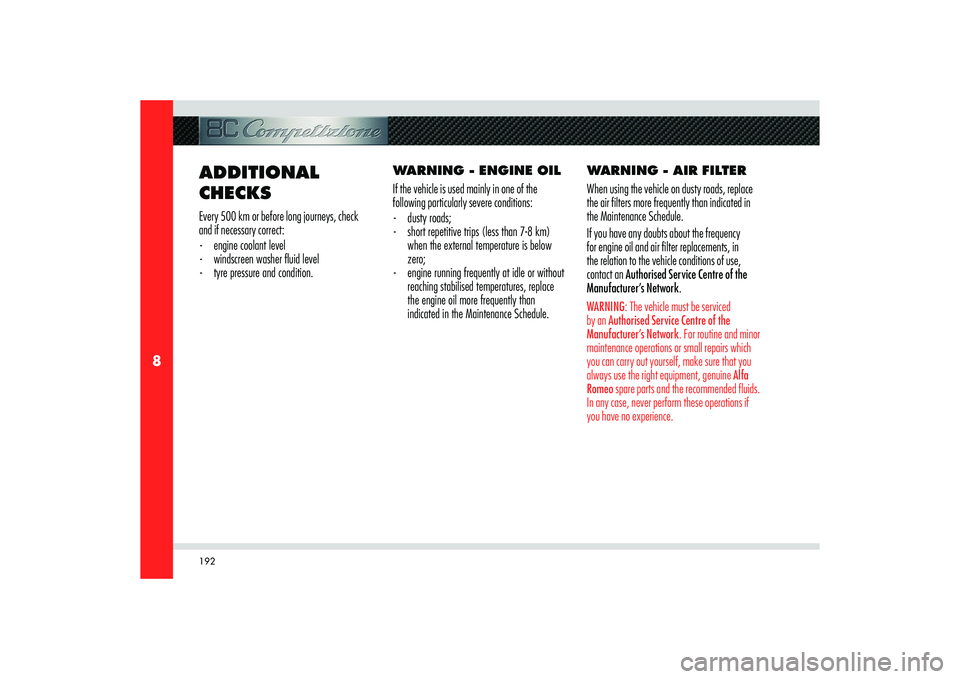
192
8
ADDITIONAL
CHECKSEvery 500 km or before long journeys, check
and if necessary correct:
- engine coolant level
- windscreen washer fl uid level
- tyre pressure and condition.WARNING - ENGINE OIL
If the vehicle is used mainly in one of the
following particularly severe conditions:
- dusty roads;
- short repetitive trips (less than 7-8 km)
when the external temperature is below
zero;
- engine running frequently at idle or without
reaching stabilised temperatures, replace
the engine oil more frequently than
indicated in the Maintenance Schedule. WARNING - AIR FILTER
When using the vehicle on dusty roads, replace
the air filters more frequently than indicated in
the Maintenance Schedule.
If you have any doubts about the frequency
for engine oil and air filter replacements, in
the relation to the vehicle conditions of use,
contact an Authorised Service Centre of the
Manufacturer’s Network.
WARNING: The vehicle must be serviced
by an Authorised Service Centre of the
Manufacturer’s Network. For routine and minor
maintenance operations or small repairs which
you can carry out yourself, make sure that you
always use the right equipment, genuine Alfa
Romeo spare parts and the recommended fluids.
In any case, never perform these operations if
you have no experience.
Page 203 of 223

201
8
MAINTENANCE
HOW TO USE THE TYRESWARNING: The tyres must be constantly kept in
good conditions to ensure safe driving.Tyre inflation pressure must correspond to the
prescribed values and should be checked only
when the tyres are cold: the pressure increases
as the tyre temperature progressively increases.
Never reduce the pressure if tyres are warm.
Insufficient tyre inflating pressure can cause tyre
overheating and possible internal damages,
which may even lead to the tyre destruction.
CAUTION
Check the tyre inflating
pressure at least every two weeks and
before long trips.
Impacts with kerbs, holes, and obstacles in the
road, as well as prolonged trips on rough roads
can cause tyre damage which may not be visible
to the naked eye.
Check your tyres regularly for any signs of
damage (e.g. scratches, cuts, cracks, bulges,
etc.).
If sharp objects penetrate the tyres, they can
cause damage which is only visible when the tyre
is removed.
In any case, any possible damage must be
inspected by an experienced tyre fitter, as it may
seriously reduce the tyre life.
Remember that tyres deteriorate with time, even
if used little or not at all.
Cracks in the tyre tread and sides, alongside
possible bulging, are a sign of deterioration.
CAUTION
Have the old tyres inspected
by an experienced tyre fitter, to make
sure they can still be used safely. If the
same tyre has been on your vehicle for
4 or 5 years, have it inspected anyway
by an experienced tyre fitter.
CAUTION
Never fit tyres of uncertain
origin.
CAUTION
“Directional” tyres have an
arrow on their side showing the
rolling direction. To maintain optimal
performance when replacing a tyre,
make sure that the rolling direction
corresponds to the one marked by the
arrow.